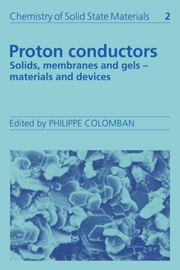Book contents
- Frontmatter
- Contents
- List of contributors
- Preface
- Symbols
- I HYDROGEN BOND AND PROTONIC SPECIES
- II MATERIALS: PREPARATION, STRUCTURES AND PROPERTIES
- 7 Structure and characterization of hydrogen insertion compounds of metal oxides
- 8 High temperature proton conductors based on perovskite-type oxides
- 9 Highly ionic hydroxides: unexpected proton conductivity in Mg(OH)2 and homologues
- 10 Ice
- 11 Anhydrous materials: oxonium perchlorate, acid phosphates, arsenates, sulphates and selenates
- 12 Hydrogen behaviour in graphite–nitric acid intercalation compounds
- 13 Proton-containing β- and β″-alumina structure type compounds
- 14 Proton conduction in zeolites
- 15 Proton containing NASICON phases
- 16 Phosphates and phosphonates of tetravalent metals as protonic conductors
- 17 Hydrogen uranyl phosphate, H3OUO4PO4. 3H2O (HUP), and related materials
- 18 From crystalline to amorphous (particle) hydrates: inorganic polymers, glasses, clays, gels and porous media
- 19 Perfluorinated membranes
- 20 Mixed inorganic-organic systems: the acid/polymer blends
- III PROTON DYNAMICS AND CHARGE TRANSPORT
- IV PROTON DIFFUSION MECHANISMS
- V DEVICES
- Index
10 - Ice
Published online by Cambridge University Press: 04 May 2010
- Frontmatter
- Contents
- List of contributors
- Preface
- Symbols
- I HYDROGEN BOND AND PROTONIC SPECIES
- II MATERIALS: PREPARATION, STRUCTURES AND PROPERTIES
- 7 Structure and characterization of hydrogen insertion compounds of metal oxides
- 8 High temperature proton conductors based on perovskite-type oxides
- 9 Highly ionic hydroxides: unexpected proton conductivity in Mg(OH)2 and homologues
- 10 Ice
- 11 Anhydrous materials: oxonium perchlorate, acid phosphates, arsenates, sulphates and selenates
- 12 Hydrogen behaviour in graphite–nitric acid intercalation compounds
- 13 Proton-containing β- and β″-alumina structure type compounds
- 14 Proton conduction in zeolites
- 15 Proton containing NASICON phases
- 16 Phosphates and phosphonates of tetravalent metals as protonic conductors
- 17 Hydrogen uranyl phosphate, H3OUO4PO4. 3H2O (HUP), and related materials
- 18 From crystalline to amorphous (particle) hydrates: inorganic polymers, glasses, clays, gels and porous media
- 19 Perfluorinated membranes
- 20 Mixed inorganic-organic systems: the acid/polymer blends
- III PROTON DYNAMICS AND CHARGE TRANSPORT
- IV PROTON DIFFUSION MECHANISMS
- V DEVICES
- Index
Summary
Introduction
Vast masses of ice and snow on the Earth play an important part in our life. Nevertheless, ice is not a traditional topic in solid state physics. This is explained by difficulties of making controlled and reproducible experiments with ice for the following reasons.
First, ice has a large number of solid modifications: hexagonal or ordinary ice, Ih; cubic ice, Ic; ices II–IX; vitreous ice. Most of them exist at elevated pressure or need special formation conditions. Under ordinary conditions, only hexagonal ice is formed, which has therefore been investigated more frequently than other modifications. In this chapter we shall deal only with ordinary ice.
Second, ice is an unusual example of the solid state, since it consists of two very different parts: a crystalline, hard lattice of oxygen atoms and a disordered, quasi-liquid proton system. For this reason, the physical properties of ice are intermediate between those of a solid and a liquid.
Third, as a rule ice contains various impurities, whose distribution, homogeneity and concentration are very hard to control and which strongly affect the physical properties of ice.
In spite of such difficulties, by the beginning of the 1970s the essential principles of ice physics had been formulated. Using them it is possible to explain the unusual properties of ice and to predict the behaviour of ice under different conditions.
- Type
- Chapter
- Information
- Proton ConductorsSolids, Membranes and Gels - Materials and Devices, pp. 158 - 164Publisher: Cambridge University PressPrint publication year: 1992



